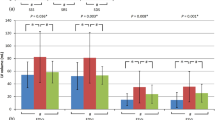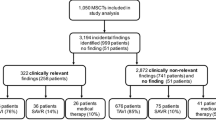Abstract
Background
The purpose of the present study was to evaluate the benefits of a preoperative dipyridamole thallium-201 myocardial perfusion scan in patients undergoing abdominal aortic aneurysm (AAA) repair.
Methods
We retrospectively reviewed findings in a prospectively collected database of patients undergoing open or endovascular repair of AAA at the Asan Medical Center, Seoul, Korea, from January 2001 to May 2011.
Results
Of 373 patients, 11 (2.9 %) had postoperative myocardial infarction (MI), whereas 24 (6.4 %), 17 (4.6 %), 24 (6.4 %), and 8 (2.1 %) were diagnosed with myocardial ischemia, atrial fibrillation, ventricular arrhythmia, and congestive heart failure, respectively. The incidence of 30-day cardiac-related mortality was 1.6 % (6 of 373 patients). The preoperative variables significantly associated with postoperative cardiac events in multivariate analysis were preoperative congestive heart failure (odds ratio [OR] 8.8, 95 % confidence interval [CI] 1.36–56.73, p = 0.022), long-acting nitrates (OR 8.1, 95 % CI 1.22–54.26, p = 0.03), and body mass index (BMI) higher than 26 (OR 3.6, 95 % CI 1.49–8.48, p = 0.004). The variables obtained from dipyridamole thallium-201 myocardial perfusion scan were not correlates of postoperative cardiac events. The sensitivity of reversible defects for postoperative cardiac events was 14 % and the specificity was 90 %. Subgroup analyses revealed that thallium defects were not significant variables in predicting postoperative cardiac events in patients with coronary artery disease (CAD) or in no-CAD patients.
Conclusions
Preoperative dipyridamole thallium-201 myocardial perfusion scans were ineffective in predicting postoperative cardiac complications in AAA patients. These results suggest that the routine use of these tests for preoperative screening of patients undergoing AAA repair may not be warranted.


Similar content being viewed by others
References
Massie MT, Rohrer MJ, Leppo JA et al (1997) Is coronary angiography necessary for vascular surgery patients who have positive results of dipyridamole thallium scans? J Vasc Surg 25:975–983
Ferro CR, Oliveira DC, Guerra FF et al (2007) Prevalence of and risk factors for combined coronary artery disease and aortic aneurysm. Arq Bras Cardiol 88:37–40
Lette J, Waters D, Lassonde J et al (1990) Postoperative myocardial infarction and cardiac death. Ann Surg 211:84–90
McFalls EO, Doliszny KM, Grund F et al (1993) Angina and persistent exercise thallium defects: independent risk factors in elective vascular surgery. J Am Coll Cardiol 21:1347–1352
Boersma E, Poldermans D, Bax JJ et al (2001) Predictors of cardiac events after major vascular surgery. JAMA 285:1865–1873
Bub GL, Greenberg RK, Mastracci TM et al (2011) Perioperative cardiac events in endovascular repair of complex aortic aneurysms and association with preoperative studies. J Vasc Surg 53:21–27
Thygesen K, Alpert JS, White HD et al (2007) Universal definition of myocardial infarction. Circulation 116:2634–2653
Baron JF, Mundler O, Bertrand M et al (1994) Dipyridamole-thallium scintigraphy and gated radionuclide angiography to assess cardiac risk before abdominal aortic surgery. N Engl J Med 330:663–669
Mangano DT, London MJ, Tubau JF et al (1991) Dipyridamole thallium-201 scintigraphy as a preoperative screening test: a reexamination of its predictive potential. Circulation 84:493–502
Jamieson WRE, Janusz MT, Miyagishima RT (1982) Influence of ischemic heart disease on early and late mortality after surgery for peripheral occlusive vascular disease. Circulation 66(Suppl I):I92–97
Detsky AS, Abrams HB, McLaughlin JR et al (1986) Predicting cardiac complications in patients undergoing non-cardiac surgery. J Gen Intern Med 1:211–219
DeBakey ME, Lawrie GM (1984) Combined coronary artery and peripheral vascular disease: recognition and treatment. J Vasc Surg 1:605–607
Cutler BS, Leppo JA (1987) Dipyridamole thallium 201 scintigraphy to detect coronary artery disease before abdominal aortic surgery. J Vasc Surg 5:91–100
Leppo J, Plaja J, Gionet M et al (1987) Noninvasive evaluation of cardiac risk before elective vascular surgery. J Am Coll Cardiol 9:269–276
Eagle KA, Singer DE, Brewster DC et al (1987) Dipyridamole-thallium scanning in patients undergoing vascular surgery. JAMA 257:2185–2189
Schueppert MT, Kresowik TF, Corry DC et al (1996) Selection of patients for cardiac evaluation before peripheral vascular operation. J Vasc Surg 23:802–809
Mason JJ, Owens DK, Harris RA et al (1995) The role of coronary angiography and coronary revascularization before noncardiac vascular surgery. JAMA 273:1919–1925
McFalls EO, Ward HB, Moritz TE et al (2004) Coronary-artery revascularization before elective major vascular surgery. N Engl J Med 351:2795–2804
Seeger JM, Rosenthal GR, Self SB et al (1994) Does routine stress-thallium cardiac scanning reduce postoperative cardiac complication. Ann Surg 219:654–663
Golden MA, Whittemore AD, Donaldson MC et al (1990) Selective evaluation and management of coronary artery disease in patients undergoing repair of abdominal aortic aneurysms. Ann Surg 212:415–420
Chang SM, Hakeem A, Nagueh SF (2009) Predicting clinically unrecognized coronary artery disease: use of two-dimensional echocardiography. Cardiovasc Ultrasound 7:10
Kühl JT, Kofoed KF, Møller JE et al (2010) Assessment of left atrial volume and mechanical function in ischemic heart disease: a multi slice computed tomography study. Int J Cardiol 145:197–202
Author information
Authors and Affiliations
Corresponding author
Rights and permissions
About this article
Cite this article
Shin, S., Kwon, TW., Cho, YP. et al. Preoperative Cardiac Evaluation by Dipyridamole Thallium-201 Myocardial Perfusion Scan Provides no Benefit in Patients with Abdominal Aortic Aneurysm. World J Surg 37, 2965–2971 (2013). https://doi.org/10.1007/s00268-013-2200-9
Published:
Issue Date:
DOI: https://doi.org/10.1007/s00268-013-2200-9




